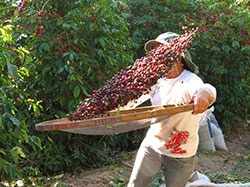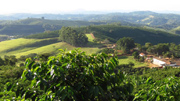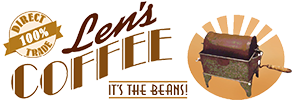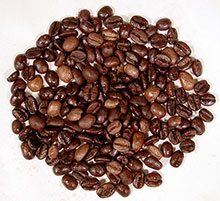- Home
- Roast Levels
Roast Levels
Different roasting companies use verbal terminology to mean different things--one person's city roast is another person's dark roast, for example. When we began roasting our own coffees, we realized telling our customers that our coffees were "dark" or "medium" or "Italian" wouldn't be helpful if those words could mean a wide range of roasts!
To that end, we have made the roast comparison chart below. This scale will be consistent throughout the store, so if you're ever unsure what we mean, just check back here. Hope this is helpful!
If you'd like more information about roasting, please continue on and read the article below the chart.

Specialty Roasts Not Listed In That Chart
Harlequin ™ Roast: Our Own Multi-Temperature Roasting
Harlequin Roast is a combination of multiple roast points, expertly blended. We use this technique to bring out the best in coffees that shine at more than one roast level. Do you wish you could enjoy the toasty richness of a medium-dark roast without losing the delicate sweetness of a lighter roast? With Harlequin Roast, you can have the best of both worlds.
Every Harlequin-roasted coffee is formulated with a unique and optimal percentage of darker and lighter roasts. This requires a lot of taste-testing by us here in the office--it's a rough job, but someone's got to do it! Generally speaking, however, we use about 18-25% lighter roast (levels 2-3 on the chart above) and 75-82% darker roast (levels 4-5).
If you buy Harlequin roasted coffee in whole bean, you'll be able to see the two colors of bean; this two-toned effect is what gives Harlequin its name. Whether whole bean or ground, you'll taste the multiple roasts singing a duet in your cup. And the aroma! If you're like us, you'll want to stick your nose right in your mug to get all the delicious layers of aroma.
Harlequin roast requires a much bigger investment from us, so we can't offer all coffees in this roast. That's okay, though, since most of our coffees strongly prefer to be one roast or another. Harlequin roast is for those rare specialties that offer something unique and delicious at two distinct roast points. The original Harlequin roast coffee was our Costa Rica Dota Tarrazu "Nectar", and we believe it's as close to a perfect coffee as you'll find this side of Heaven.
Limoncello Roast - new light roast for select coffees
Blonde Roast? Light Roast? Aren't those coffees painfully acidic and weak? That's what we thought... until we realized the problem with blonde roasts isn't the roast. It's the bean!
When we tried roasting our new Catimor to a very light 410 degrees, something magical happened. The Catimor bloomed with exactly those fruity, lemony flavors so prized by lovers of light roasts, but with none of the usual downsides. The acidity is normal, and the body is full and rich. It is intensely flavorful: after an initial rush of lemon zest, you get layers of sweet molasses and butter, followed by a deliciously lingering finish with hints of caramel.
This is our Limoncello Roast, our most precisely calibrated Master Roast ever, and named after the famous Italian lemon liqueur. It's wonderful served hot, and even better on ice. We consider this one of the top 3 iced coffees we've ever had. Currently, we offer only the Catimor as a Limoncello Roast, although we will continue to experiment with other coffees and blends to see if it suits them.
Coffee Roast Misconceptions
There are a lot of misconceptions about coffee roasting, mostly as a result of large coffeeshop chains' advertising campaigns trying to convince the public that black is black and white is white and there's no such thing as a shade of gray - not to mention all the other colors. To help clear some of the confusion, we've addressed some of the most common ones here.
Myth: All the best coffees are dark roasts.
This is a lot like the commonly stated "All the best chefs cook over high heat." You can't cook ice cream over high heat, and not every bean benefits from a dark roast. The most delicate beans, including most Kopi Luwak (civet) coffees, should not be roasted darker than City, or subtle flavor elements and aromas may be lost, burned away in the high heat.
Common Misunderstanding: If you like French Roast coffees, then French Roast is what you like.
An amazingly high percentage of people we meet at markets and coffee tastings who tell us that they like French Roast were actually looking for the strongest or most intensely flavorful coffee. After years of exposure to mass market American coffee, they learned that the most reliable way to get the intense experience they desired was to go straight for the darkest roast. French roast is often used as a way to "punch up" lackluster coffee beans, which is why many coffee chains' darkest roast is their strongest-tasting coffee.
However, when roasting beans that are already inherently flavorful, the "strength" (by which we mean flavor, NOT caffeine content) is not improved by roasting it past Medium roast. In fact, as mentioned above, in some coffees the subtlety can be lost, reducing the overall mouth-filling intensity of the flavor.
This is not to say that French Roast is bad. French Roast adds an element of smokey, slightly bitter caramel, which is the natural coffee sugars being caramelized in the high heat. Some people really respond to this and crave it in their coffees, and that's great! We love to make people happy. Indochine French Roast is an excellent choice for these individuals.
But many of our other customers find out after some experimentation that French Roast was just a means to an end, a way of seeking the strongest-tasting coffee. If this sounds right to you, then we suggest trying a multi-bean blend in a medium roast, ideally with Robusta in it.
Myth: Dark roast is lower in acid.
As with many myths, this one has a basis in fact. Light roast coffees are often quite acidic. Roasting the beans a little darker, to Medium or City roast, can temper that acidity. But once you go past Full City, the acid starts to rise again, because the sugars are being scorched. The darker you go, the more of the natural sugars are blackened. The result can be extremely hard on a person's stomach, and many individuals have an allergy-like reaction, experiencing headaches, stomachaches, and generally not feeling good.
For this reason, we recommend Medium roast coffees to any person who has a sensitive stomach, wants to protect their teeth, or simply prefers the taste of a lower-acid coffee.
But even more important than that is to seek out a naturally lower-acid bean. Arabica tends to be the highest in acid, then Robusta, Excelsa, and finally Liberica. This is itself an oversimplification, so we suggest seekers of low-acid coffees look for the words "Low in acid" in a coffee's description. Some of our lowest acid coffees include our Dalat Paradise Blend, Philippine Bantai Robusta or Dalat Peaberry Robusta (or any Robusta based coffee, like Trung Nguyen Creative 1), Indochine Sun Blend, Dalat Bourbon Arabica, and most Kopi Luwak coffees including Trung Nguyen Legendee, which is "civet process" coffee.
Myth: Dark/Light roast is higher/lower in caffeine.
We've heard this myth both ways! The truth is that roast level has some... but minimal effect on caffeine content in comparison to other factors. What determines caffeine content is the species or altitude of the bean itself. Arabica, which is generally considered the "baseline" or average, contains ~90 mg of caffeine per 6oz serving of brewed coffee. Robusta is higher, averaging ~150 mg, and Liberica and Excelsa are both lower. Super-high-altitude beans like our Costa Rica and Philippine Robusta have less caffeine than lower-altitude beans (maybe by a factor of 10-20%).
We hope this helps you pick out the best coffee for your taste. It's our firm belief that every individual's palate is unique, and that's why we strive to offer a wide variety of top-quality coffees that suit an equally wide variety of people. Diversity is a beautiful thing!
Latest Blog Post

Get to know our Brazil Microlots!
These volcanic soil coffees are delicious and diverse... Read more...
Resources
Featured Region

The Araku Valley of India
India's coffee tradition goes back 400 years or more, when a variety called Kent was first established in the Southern Hills. Arabicas predominated until the blight of 1870, when growers needed to hybridize to resistant varieties. The resultant strains had genes from Liberica and other unique, resistant species. Learn more and browse India's Araku Valley coffees here.
 Loading... Please wait...
Loading... Please wait...



